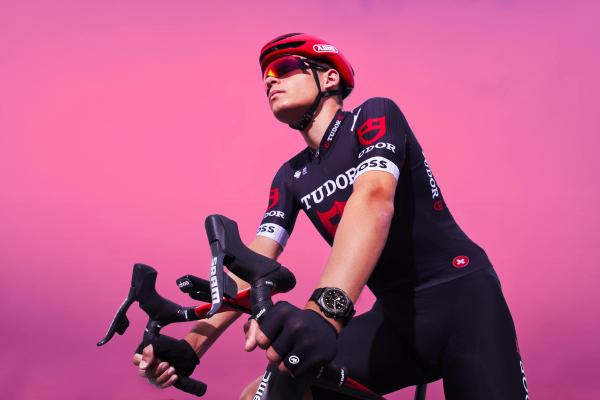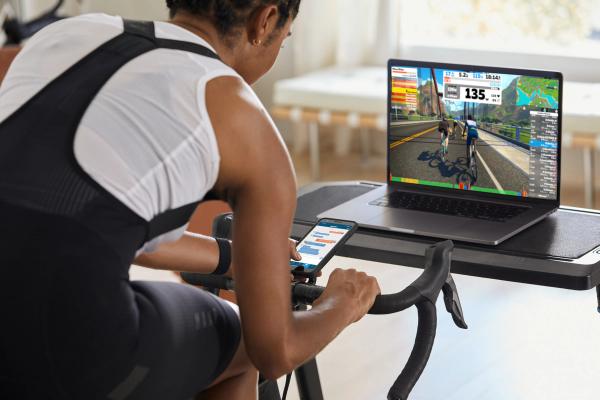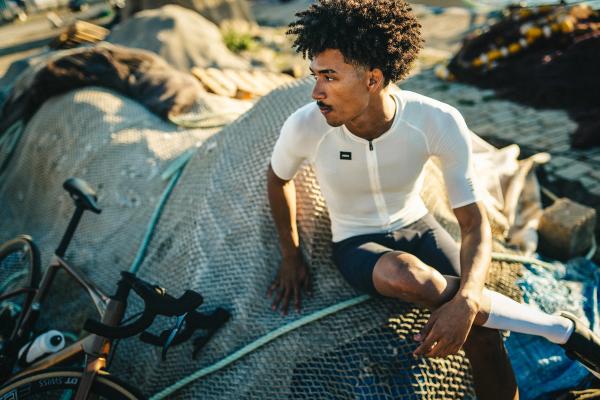Tech analysis: The inexact science of Paris-Roubaix
It’s not a case of 'one size fits all' when teams are deciding on what equipment to use for the tough cobbled Monument
Alex Hunt
Junior Tech Writer
© GCN
It appears like the ideal Roubaix set-up is still open for discussion
Paris-Roubaix is the most testing one-day race on the WorldTour calendar, for both equipment and riders. This has often led to riders modifying their equipment to help them sail over the cobbles without issue.
At this year's edition of the race, we took a close look at what the teams would be using at the 'Hell of the North’ and discovered that seemingly no one can agree on what the ideal setup is for the cobbled Monument.
Unlike the rest of the professional calendar, the best equipment for the northern French cobbles is open to interpretation. When looking across all the teams in the paddock ahead of the race it becomes apparent that every team has its own strategy backed up by its own rationale.
The course of the men's Paris-Roubaix is a hard one when it comes to equipment choices because although there is 59.7km of pavé to navigate on the way to Roubaix Velodrome, there is also 200km of smooth tarmac to race across. Another consideration is the speed of the race with this year’s Paris-Roubaix setting a new record finishing pace of 47.8kph, which means that aerodynamics is an unavoidable component in the equation of success.
This blend of aerodynamic optimisation, comfort and performance leads teams down different avenues in the hunt for success. In the modern era of science-driven performance gains, Paris-Roubaix looks – from the outside at least – open to interpretation more so than any other race.
Aero bike, endurance bike or gravel bike?
If you look at the history of Roubaix it would appear that an endurance bike would be the natural choice to get you to the velodrome in the fastest time. If we look at the bike that shares its name with the iconic race, the Specialized Roubaix it has won the race more times than any other bike since its launch in 2004.

© GCN
There was not a single Specialized Roubaix present in either the men's or women's field
With this stat in mind, it was interesting to learn that not a single Specialized team from either the men’s or women’s race took to the start on the Roubaix instead the teams all opted to use the Tarmac. When asked why this was, the mechanics from Bora-Hansgrohe said it was due to the higher speeds of the races and the increase in tyre clearance that modern race bikes have which meant the Tarmac was the go-to choice. It is hard to argue with the team’s decision as Lotte Kopecky rode her S-Works Tarmac to victory in the women’s race.
However, not all teams seemed to agree that using their dedicated race bikes was the right strategy for ‘the Hell of the North’. Most notable was Israel-Premier Tech who made the bold decision to use their bike sponsor Factor’s gravel race bike the Ostro Gravel. This wasn’t a decision driven by the need for greater tyre clearance as the team stuck to 32mm tyres even though the frame can accept up to 45 mm tyres. The decision was actually based on the geometry of the Ostro Gravel. The longer and more relaxed geometry of the Ostro Gravel was chosen by the team as it made the bike more composed on the rough pavé sectors of the race.
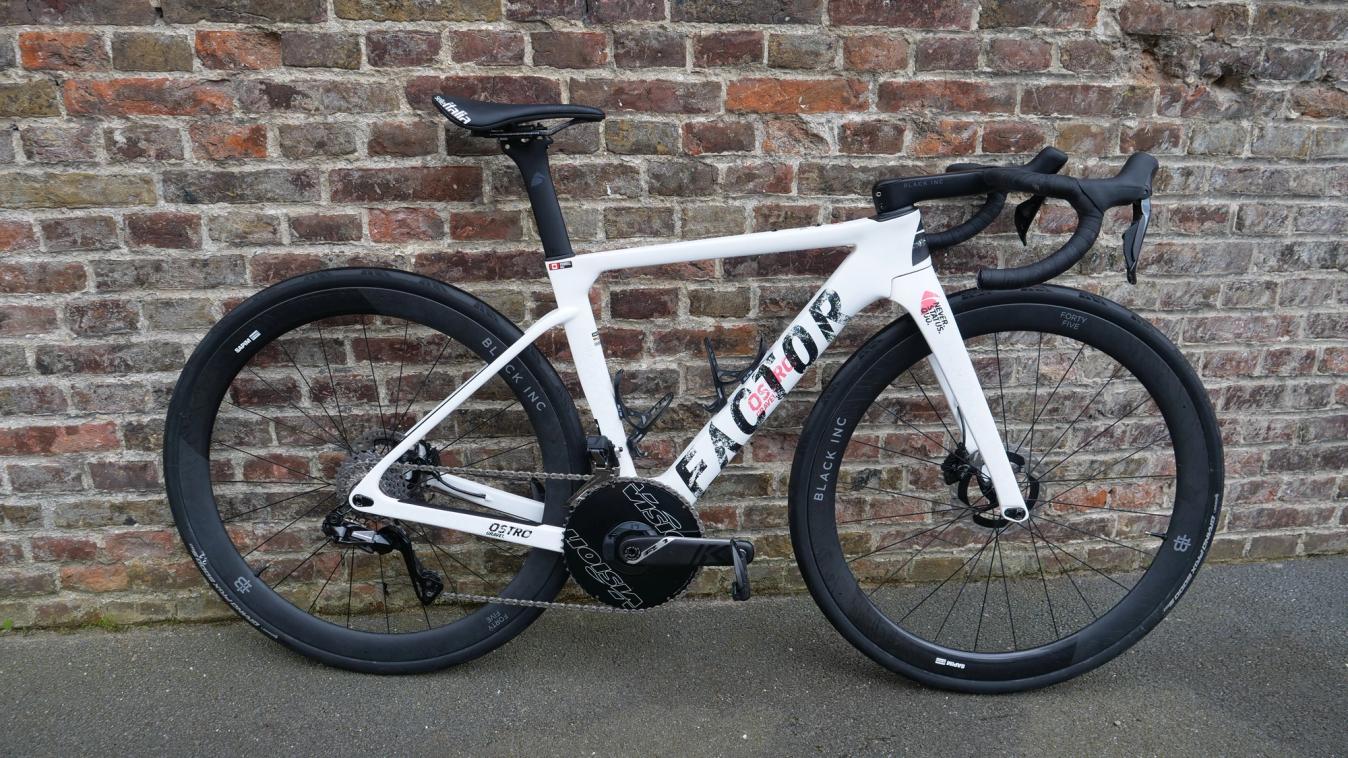
© GCN
Israel-Premier Tech made the bold choice to use a gravel bike for Paris-Roubaix
It also isn’t a clear-cut decision within the teams themselves. The team of Arkéa-B&B Hotels were using both the Bianchi Oltre and the Specialissima at the race. The Oltre is the brand’s out-and-out aero bike while the Specialissima is the brand’s light weight package. Given the flat parcours of Paris-Roubaix and the high average speed that comes with it, the Oltre would be the natural choice, however due to the frame profiles of an aero bike, they tend to be stiffer than lightweight bikes making them harsher over the cobbles.
Men’s and women’s teams also took different strategies, with Factor-sponsored women’s team Human Powered Health sticking to the Ostro VAM rather than the Ostro Gravel. At Canyon-SRAM, they made the decision to use the Canyon Ultimate rather than Aeroad once again for the increase in vertical compliance that the Ultimate has as well as allowing some of the team to use 35mm gravel tyres for increased confidence during the race.
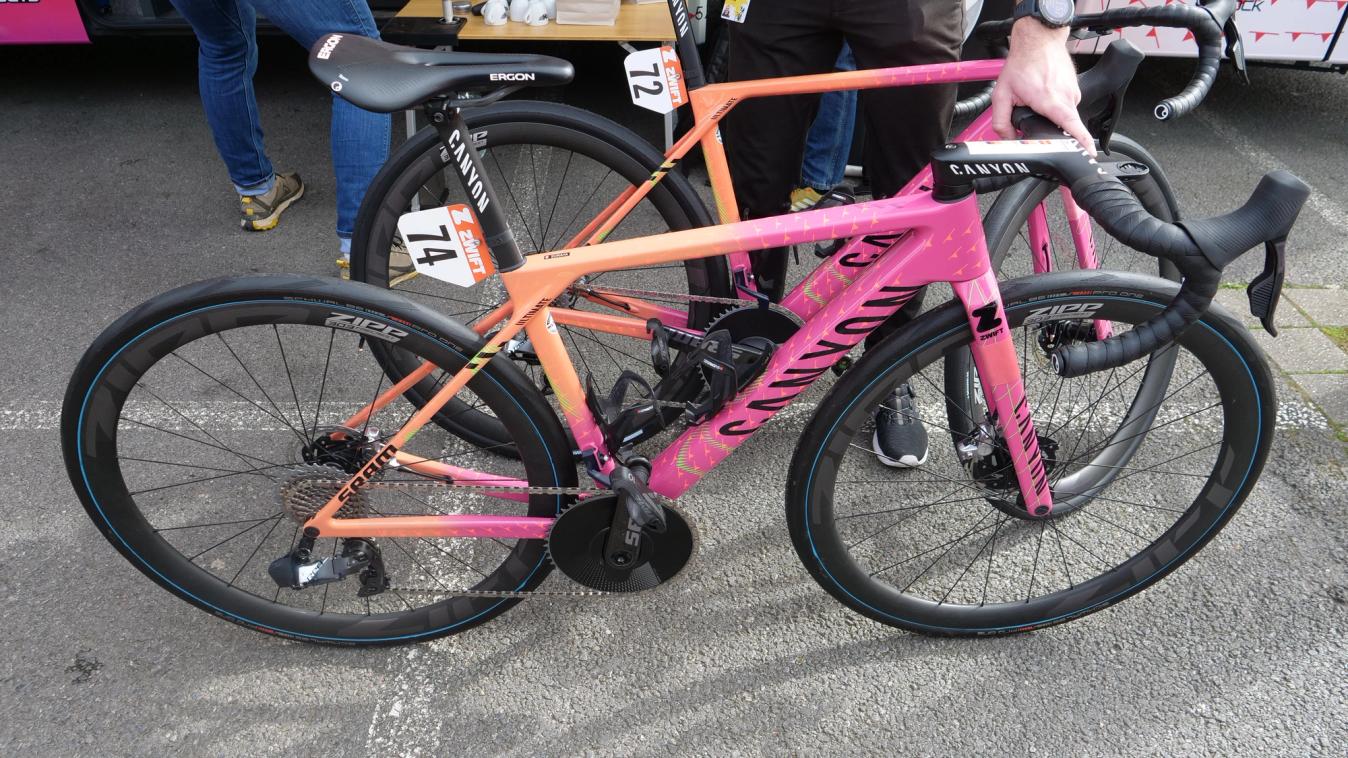
© GCN
Canyon-SRAM made the decision to use Canyon's Ultimate frame rather than the Aeroad for better tyre clearance and compliance
The women’s and men’s outfits of Lidl-Trek also approached the race with differing strategies. The men all opted to use the Madone aero race bike from Trek with Mads Pedersen putting it to good use on his way to third place on the day.
For the women there was less of a clearly defined approach to equipment with some riders opting to use the Madone, however the majority of the team made the call to use the brand's endurance bike the Domane. This was in part due to the women in general being lighter than the men and benefiting more from the compliance of the Domane frameset. On a stiff aero bike, lighter riders can quickly find themselves getting bounced around on the cobbles making forward progress difficult.
30mm, 32mm, or 35mm tyres
Another area that seemed to be open to interpretation was what the best tyre width was. The overwhelming consensus among all teams was the 32mm tyres were the most popular choice. For most aero race bikes this is at the limit of their tyre clearance and offer the best blend in regards to grip, puncture resistance and rolling resistance. This didn’t stop the eventual winner of the men’s race Mathieu van der Poel using a bike fitted with 28mm tyres for the first 100km of the race before swapping to a different bike with 32mm tyres just before the race hit the first sector of pavé.

© GCN
Jayco AlUla were using 30mm tyres for Roubaix making them some of the narrowest in the race
Although most teams did run 32mm tyres, there were some exceptions to this rule with both Lotto Dstny and Jayco AlUla using 30mm tyres. For Lotto, this was simply because the clearance of the frames did not allow for any wider tyres to be fitted, with the 30mm Vittoria Corsa Pro already pushing the limit on what would fit in the frame.
At the other end of the spectrum, there was Bahrain Victorious in the men's field and some riders from Canyon-SRAM and SD Worx-Protime in the women’s who took things to the max squeezing 35mm tyres into their frames.
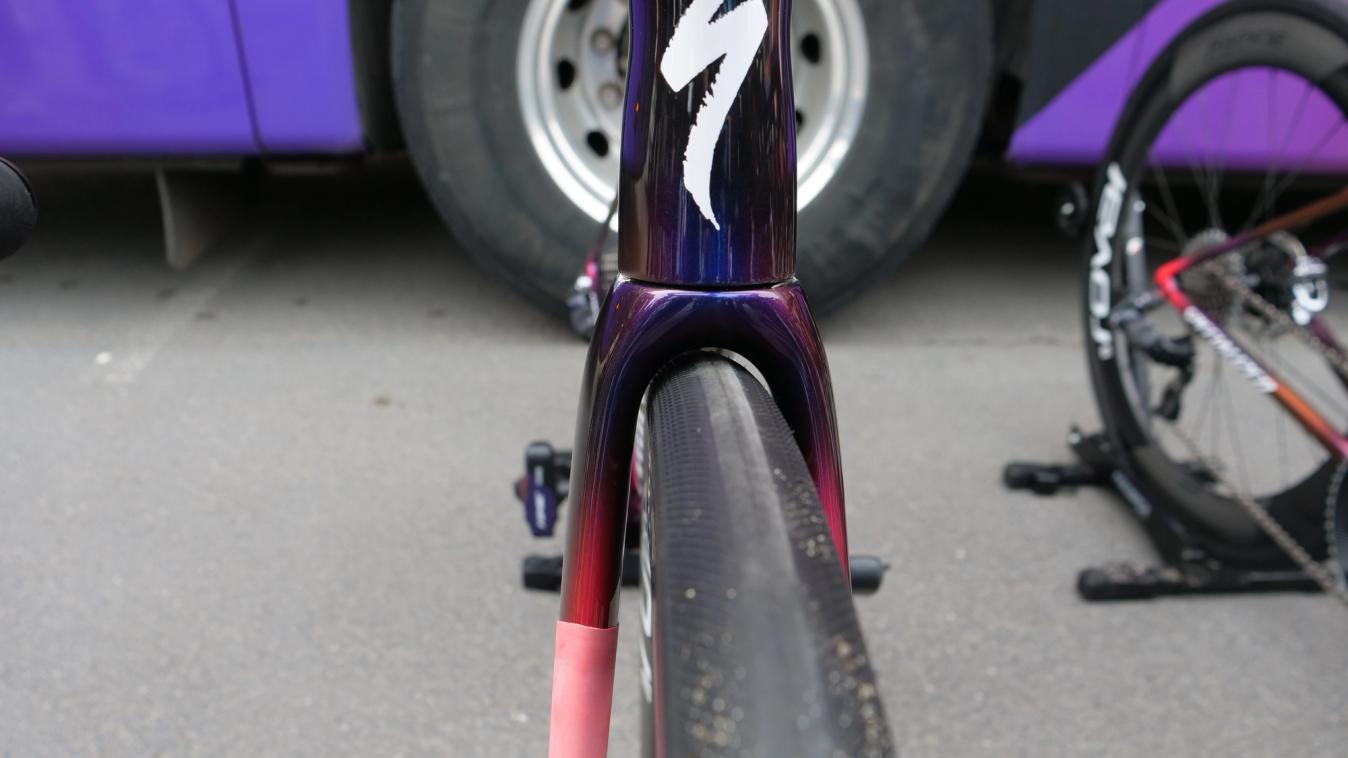
© GCN
At the other end of the spectrum there was SD Worx-Protime that used 35mm tyres on some of the teams bikes
There is no denying that a 35mm tyre will give better compliance over the cobbles and reduces the risk of impact punctures, however other teams rejected the idea due to concerns around the aero penalty for riding such wide tyres.
Deep wheels or shallow wheels
At the start of the men’s race although it was clear that mid-section wheels or deeper were the standard choices across the peloton, however it was interesting to see that some teams supported by the same brands took a different approach.
Multiple teams that were supported by Vision decided to run the Metron 45SL wheelset for Roubaix. When talking to an EF-Education Cannondale mechanic ahead of the women’s race, he explained that the team chose to run the 45mm deep wheels partly because of the wind but also because they provide better acceleration than the 60mm deep wheels. He also explained that because the 45mm deep rims use a slightly longer spoke than the 60mm rims, they offer slightly more compliance helping to increase rider comfort over the cobbles.
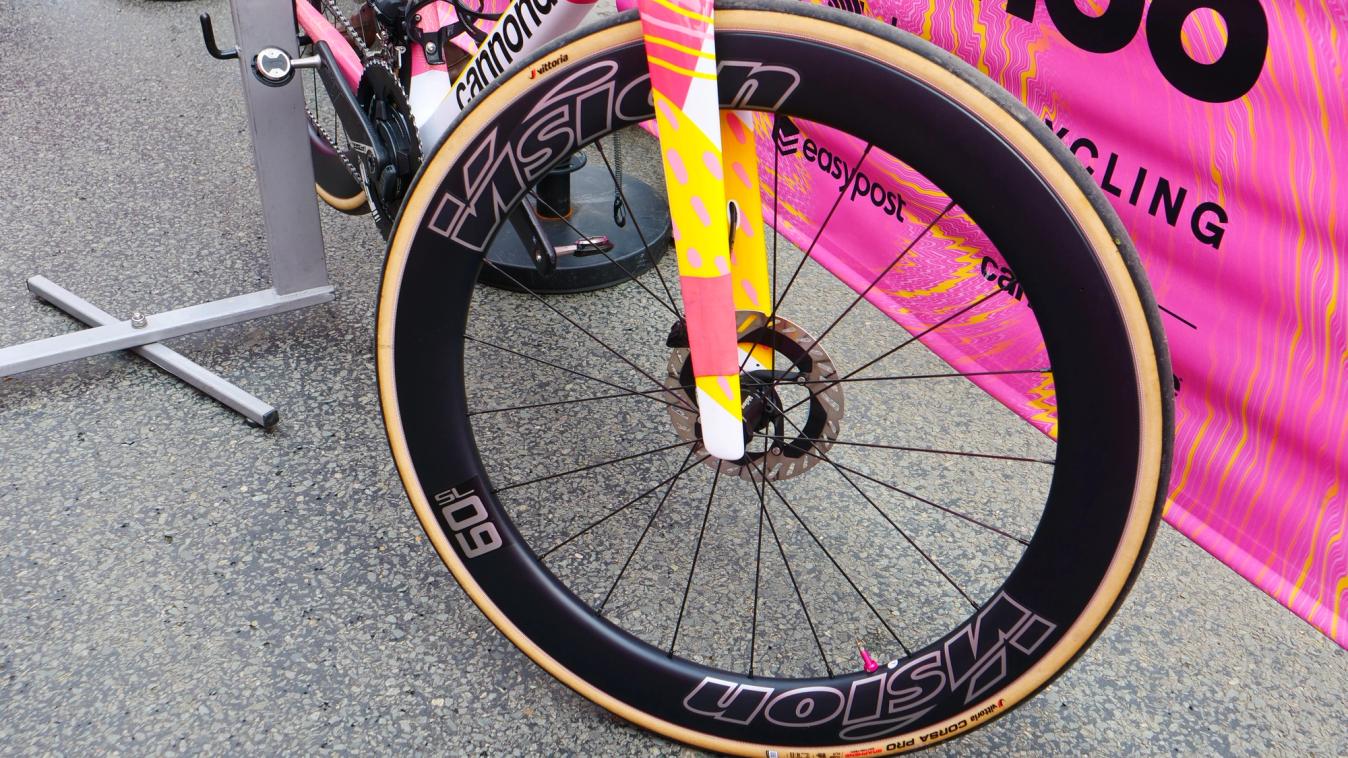
© GCN
Teams couldn't decide on what wheel depth was best with riders' preference the deciding factor
The teams of both Lotto Dstny and Movistar opted to use the shallower 303 or 353NSW wheels rather than the deeper 454NSW rims. This was in part due to the wider internal rim width of the shallower wheels providing a better interface for the 32mm tyres.
At a glance around the peloton, it was clear that teams had all reached their own conclusions about which wheelset they had at their disposal would be best. Very few teams actually chose to run the deepest rims they could, with the Shimano sponsored teams all using the C50 rather than the C60 wheelset. Astana Qazaqstan were one of the few teams that did use the deepest wheels they have available with the team using the Vision Metron 60SL wheelset.
Bars and stems seem favourable over one-piece cockpits
Paris-Roubaix is really a race unlike any other when it comes to equipment. It is understood by both teams and riders that the most important thing for a good result is to have a bike set-up in a way that the rider trusts, feels confident about and is comfortable on over the pavé. For this reason, riders are given more free reign here than at any other race to have their bikes set up how they want them. Nowhere is that more obvious than the cockpits chose to use.

© GCN
Traditional cockpits with separate bars and stems were more common than you might expect for Paris-Roubaix
At any regular road race, the peloton is a sea of fully integrated cockpits with one-piece bar and stems making up an overwhelming majority of bike setups. At Paris-Roubaix there was far more division between riders sticking to the integrated cockpits they would typically use and riders that reverted to more traditional bar and stem configurations. Even within teams, there was no conformity.
To make a generalisation, one-piece bar and stems tend to be stiffer and feature aero profiling on the tops of the bars. This can make finding a secure hand placement whilst on the pavé noticeably more challenging resulting in some riders opting to fit a round bar instead to remove this issue.
What does all of this actually mean?
In a landscape where everything is tested around aerodynamic efficiency and how many watts it can save you, Paris-Roubaix still looks to be the antidote to this. Riders might not all agree on exactly how best to set up a bike for the Hell of the North but there is something quite nice about it.
All the different set-ups go to show how much effect rider feel can have on performance at a cobbled classic and how little of it can be boiled down to an exact science. There is certainly a lot more science behind the tech at this race than in years gone by but the science looks open to interpretation.
Even though both races may have been won on seemingly regular bikes, Paris-Roubaix looks to be the last bastion of pro racing that cannot be easily broken down into an aerodynamically optimised formula. The wild and wacky tech of yesteryear might be resigned to the history books but this race still divides mechanics, riders and fans on what the right equipment really is. Will this stay the case in 10 years, we will have to wait and find out.
For all the latest from the world of cycling tech, make sure to head to our dedicated tech news section and to keep up to date with all the racing over the Classics season, make sure to head to our racing homepage.
.jpg%3Frect%3D149%2C0%2C1623%2C1080%26w%3D1280%26h%3D852%26auto%3Dformat&w=3840&q=90)













.jpg?w=600&auto=format)
